|
October 11, 2000 Notebook Faculty File: Connecting the arts The
Class of 2004 arrives Geological
fault line Inhibiting
cancer cells Faculty
File: In 1980, when John Wilmerding, then the assistant director of the National Gallery, organized a show of American Luminist painting, he included quotations from Thoreau, Hawthorne, Emerson, and Whitman on the walls with the paintings. For the first time, he says, this made him think about the connetions between art and literature. One painting in particular, Rubens Peale with a Geranium, caused him to add science, politics, and Thomas Jefferson to his thinking. "It's a painting of a painter," Wilmerding says, "and the plant takes up half the picture. That indicates a balance between art and science. And Jefferson at that time was a man of art, letters, and botany, as well as politics." When Wilmerding came to Princeton in 1988 as Sarofim professor in American art, he designed a course around three dates in American history - 1800, 1850, and 1900. He juxtaposed examples from politics, history, natural science, architecture, literature, and art from each period to "illuminate each other." During the decade that he taught his course, American Art and Culture: The 19th Century, a book began to take shape and was finally published last fall. The book's title, Compass and Clock: Defining Moments in American Culture (Abrams), refers to the vast changes between 1800 and 1900 in the American idea of space and time. "This book came out of teaching, the process of pedagogy," Wilmerding says. Currently, Wilmerding
teaches a freshman seminar on the art and culture of New York, exploring
the Gilded Age, the Ashcan School, subways, the Stieglitz circle,
the Harlem Renaissance, and pop art. And the 19th-century course?
He doesn't offer it anymore because, he says, "The answers
are all in the book."
By Ann Waldron
Shapiro, 65, said that there was no single reason why he was leaving now, other than that he is leaving Princeton "at the top of its game." "You could never be around long enough to see all the initiatives finished," Shapiro said, "because as soon as you finish one, another is started." He did cite the successful completion of the $1.14-billion 250th anniversary campaign and said that he "feels good about the opportunities I'm leaving my successor." Robert Rawson '66, chair of the executive committeee of Princeton's board of trustees, said, "Because of the character and the extraordinary leadership of President Shapiro, it is with regret that the board accepted his resignation. But we knew this moment would come, and if you look at the university by almost any measure you see a very, very healthy institution." Although Shapiro listed improved student financial aid, the new Frist Campus Center, and the investment in campus building restoration and renovation as achievements he was proud of, he said he most wished to be remembered by what faculty and students had achieved during his tenure. "I hope people will remember that Andrew Wiles solved Fermat's Theorem, or that the history department published 21 books in one year," Shapiro said. Rawson and the search committee, which Rawson will also chair, now join Harvard and Brown in the difficult task of finding a new leader. "The sets [of appropriate candidates] for each university may be different," Rawson said when asked about the competition. "We'll just do our own thing and see what happens." Shapiro's announcement
came as this issue of PAW was going to press. Our coverage will
continue in the October 25th issue.
By J.C.M. The
Class of 2004 arrives Last month the Class of 2004 came to a campus bathed in late summer sunlight and humidity. But warm, damp air didn't faze the spirits of the newest and freshest-faced members of the Princeton community.
At Opening Exercises, on Sunday, September 10, President Shapiro spoke to a standing-room-only crowd in the Chapel, which still has ceiling-high scaffolding straddling the pews on one side for the ongoing restoration of the stained glass windows. Freshmen, who were expected to attend the exercises, for the most part arrived at the interfaith service wearing sandals, sneakers, shorts, and T-shirts. Some women wore short skirts, and at least one freshman wore a suit and tie. The only other people dressed up in the crowd were the few parents in attendance, the administrators on call, and the four student-prizewinners honored that day. They were: Peggy Ping Hsu '03, the Freshman First Honor Prize; Abbie Boggiano Liel '02, the George B. Wood Legacy Sophomore Prize; Vance Foster Serchuk '01, the George B. Wood Legacy Junior Prize; Jared George Kramer '01, the Class of 1939 Princeton Scholar award; Manfred Dietrich Laubichler GS, the Charlotte Elizabeth Procter Fellowship; and Jayanthi V. J. Wolf GS, the Harold W. Dodds Fellowship.
Shapiro, in his main address, welcomed the students, and off the bat let them know how important they were to Princeton's vitality, which he said "continues to depend on an energetic and dynamic interaction between the old and the new, between tradition and change, between faculty and students, between friends and colleagues, and between the great ideas and cultural artifacts of the past and the new ideas and innovations that are so characteristic of contemporary life." He also urged them to remember that as they gain knowledge, their ethical responsibility increases as well. "In your years on this campus, as your knowledge blossoms, so correspondingly will your power to effect change, and as a direct consequence your ethical responsibilities to the well-being and interests of others will increase. Opportunity and responsibility are companions in life's journey. . . . Each of you will have to decide how you will fulfill these obligations and how you will prepare yourselves to live moral, ethical, productive, and fruitful lives in the world beyond our campus gates." The students who form the new class, said Dean of Admission Fred Hargadon, are "high-energy young men and women, each of whom is the sort of person the others came to college to meet." This year's freshmen are more diverse than ever. Of the 1,160 students, 50.8 percent are male, 49.2 percent female; 8.9 percent international (up from 6.2) ; 12.8 percent legacy (up from 12.4); and 28.9 percent minority. The minority figure includes 13.3 percent Asian Americans (up from 11.1), 8.1 percent African Americans (up from 7.6), 6.6 Latinos (up from 6.2), and 0.9 percent Native Americans (same as last year). The top three states sending students to Princeton this year were the same as last: New Jersey, with 156 students; New York, 146; and California, 103. This year's yield, 69 percent, was the same as last year, said Steve Le Menager, acting dean of admission. This year, 40 percent of the freshman class are on need-based financial aid. Don Betterton, director of undergraduate financial aid, who provided the figure, said that the university had planned for the number to be higher. "We had hoped for 42-43 percent of students on aid, but the economy has done well, and not so many seemed to need it. When we compare ourselves to other selective colleges, however, we've held the line better than our sister institutions, who've seen 4-5 percent decreases in their aid populations." Before the university modified its financial-aid policy in 1998 to attract a more economically diverse group of students, typically 38 percent of freshmen were on aid. Graduate School This year, the Graduate School expects to enroll 571 students, but was not able to provide actual numbers before press time. Actual numbers will be published in an upcoming issue. Classes began on Thursday, September 14. Undergraduates: By L.O. Geological
fault line
At Princeton, the most recent controversy, which began percolating around Reunions and has continued into the fall, involves the Natural History Museum, located in Guyot Hall. A few months ago, it was announced that the university was going to renovate the museum's space, which features a lofty ceiling and large windows that look north to the bright, mirror-like façade of the Frist Campus Center. The reconfigured space would hold offices for the Princeton Environmental Institute (PEI), an interdisciplinary program that addresses environmental issues. The museum would be relocated. Over the summer it was mistakenly reported in the media that the museum was closing, but Provost Jeremiah Ostriker clarified the case. "The museum is not closing," he said. The museum-space renovation is the first step in a series of changes that will affect the earth sciences departments. Further construction to Guyot, including two new buildings, would yield a quadrangle that would bring together molecular biology, ecology and evolutionary biology, geosciences, PEI, and atmospheric and oceanic sciences, a Ph.D. program currently at the Forrestal campus. A new science library is part of the plan, as is a multistoried atrium in the new geosciences building, where a new natural history museum could go. George Philander, chair of the geosciences department, very much wants a new natural history museum. "One major problem with the museum as it is now is that it gives not the slightest indication as to what a vibrant science geology is at the moment," Philander said. "So what I would like is for a museum that would reflect what we actually do." He referred to the new earth sciences exhibit at the American Museum of Natural History in New York as a model museum presentation. For a new museum with updated exhibits, clearly funds are needed, and input. "What we need to do is form some committee that can get involved with the architects to make sure that at the very early stage they take into account what it is we would like to have," Philander said. In preparation for the renovation, the museum's specimens - skeletons, stones, and fossils gathered over the years by faculty and students on geological expeditions - will be sorted. Some will be put in temporary storage, others displayed at various locations on campus, according to Allen Sinisgalli, associate provost for research and project administration. It sounds like a reasonable plan: Consolidate the earth and environmental sciences, and install the museum in a better place. But, as so often happens, it is in the communication of plans that people can win or lose supporters. Philander points out that though the museum belongs to the department, the department has no jurisdiction over the space. If the administration wants to reallocate space, it can, and it has. Over the summer the university announced its intention in a terse statement: "The Museum of Natural History in Guyot Hall will close to the public Labor Day weekend in preparation for renovation of the building. The exhibit will re-open in a new and better space when the renovation project is complete." Perhaps it was the terseness of the statement that caused alumni and faculty to react. Perhaps university administrators didn't realize that many alumni and faculty hold the old museum dear to their hearts and don't want it to be dismantled or moved. Those concerned have written letters to President Shapiro (about two dozen), to local newspapers, and to PAW. For Bill Bonini, professor, emeritus, of geophysics, the issue is the space itself. He, among others, is not sure the "better" space will indeed be better. He supports updating the museum, but in its present location. "It's the museum space we're really trying to preserve. It was designed by Professor William Berryman Scott and his colleagues in the geology department a hundred years ago, and it is worth preserving with its north windows and the height." He points out that the current museum space is adequate for creating a proper and updated museum. Others cite the educational value of the museum. "A natural history museum can be a critical form of outreach to an increasingly science-illiterate citizenry," wrote Lydia Fox '81, chair of the department of geosciences at University of the Pacific. The uproar, as Philander
calls the controversy, has actually had some benefit. There has
been more discussion with the architect of the new building, Payette
Associates of Boston, about how to display the museum pieces. And
it has generated a lot of interest in how to best tell the earth's
geological history. Many of the museum's most famous artifacts,
notably the allosaurus skeleton, will continue to be displayed in
Guyot during the renovation, which, according to Sinisgalli, is
still on schedule for January.
By L.O. Inhibiting
cancer cells
In cancer cells, however, the lifespan of telomeres is extended by telomerase, a protein that occurs in 90 percent of cancer cells. This allows the cancer cells to continue to replicate. Telomerase does not usually occur in healthy cells. Virginia Zakian, a professor of molecular biology, along with her collaborator, Vincent Schultz, using baker's yeast cells, discovered another protein, called Piflp, which inhibits telomerase. This finding, published in August in Science magazine, may help cancer researchers come up with ways to treat cancer. Though the experiments were done in baker's yeast cells, Zakian said that telomere regulation has been so important throughout evolution that human cells employ many of the same mechanisms. "These are very
lowly organisms. This is what we use to bake bread," Zakian
said. "However, as we show in this paper, humans have a protein
very similar to yeast Piflp. It would be quite gratifying if it
turned out that it also functions in a similar way in humans and
could give us insights into human cancer."
Paula L. Fredriksen *79, professor of religion at Boston University, spoke September 17 on "Jesus, the Crucifixion, and the Origins of Christianity." On September 22, Halle
Berry, the actress (pictured at right), came to campus to give
the keynote address of a two-day program, called Imitating Life:
Women, Race, Film, 1932-2000, that examined Hollywood's portrayal
of isues of race and gender.
Crime is not a problem at Princeton, but if we don't stay proactive we become a victim," said Barry Weiser, crime prevention officer, The university's efforts include two new programs instituted by the Office of Public Safety. RAD, rape aggression defense system, is a 12-hour course offered to women in four 3-hour segments. In the course, women learn how to defend themselves. "It's a program incorporating simple, down-to-earth logic," Weiser said. He noted that rape is not a problem on campus. The other program, called Adopt a PUPS (Princeton University public safety officer), involves public safety officers attending events and socializing at the colleges to build relationships with the student community. While crime isn't a huge problem on campus, Weiser concedes that drinking on campus is. "We spend a lot of time dealing with drinking. Nationwide it's a concern. Public Safety has always been against public drinking. The 1999 Nude Olympics was a fiasco, not because of the nudity, but because of the drinking." The other active criminal area is burglary and theft, especially of bicycles. Public Safety sites of interest: Statistics about crime on campus: http://webware.Princeton.edu/pubsaf/ stats.htm). Listing of crimes and incidents reported to Public Safety: http://webware.Princeton.edu:80/pubsaf/blotter.htm Princeton University
Crime Stats Murder 0,0 By L.O. Princeton is making the lists, again. This year, it topped U.S. News & World Report's listing of the country's best universities. It placed ninth in Sports Illustrated for Women's rankings of best colleges for women athletes. And Men's Health magazine rated Princeton as one of the 10 most male-friendly colleges. As part of Princeton's ongoing alcohol initiative, "social-norm" posters were affixed to bulletin boards and lampposts last month letting students know that over-consumption is not universal on campus. The distinctive blue posters announced that 60 percent of Princeton students stop alcohol consumption after four drinks. Five drinks or more is considered binge drinking. Returning upperclassmen complained about a breakdown of communications between them and the university this summer. Although students knew their mailboxes would be in the Frist Campus Center, they believed their campus addresses would still be their dorm rooms (e.g., 211 Walker). It wasn't until they received letters at home in early September that they learned their addresses would change to Frist mailbox numbers. In the same letter they also discovered the student telephone prefix had been changed from 258 to 986. Many of them had already given out what they thought were their new addresses and phone numbers to friends, family, and colleagues. All quiet on front campus: Unlike last year, when protests marked the first day of class for controversial ethicist Peter Singer, this year there was not a peep. Singer, who teaches the freshman seminar How Are We To Live?, said that the current level of protests against him was "zero." This year's 250th anniversary visiting professors for distinguished teaching are Gregory E. van der Vink *83 and Melissa S. Williams. Van der Vink, director of planning for IRIS, a university research consortium supported by the National Science Foundation, has taught at Princeton before and will again teach Environmental Decision-Making in the geosciences department. Williams, an associate professor of political science at the University of Toronto, joined the faculty of the Center for Human Values and will teach a course on equality in the spring. Three professors have been named to the American Philosophical Society: William Jordan, professor of history; Shirley Tilghman, professor in life sciences; and Frederick Mote, professor, emeritus, of East Asian studies. Jordan also received the Charles Homer Haskins medal from the Medieval Academy of America for his book The Great Famine: Northern Europe in the Early Fourteenth Century (Princeton University Press). Phillip James Peebles *62, professor, emeritus, of physics, was awarded the $150,000 Cosmology Prize of the Peter Gruber Foundation for his work in explaining the origin and structure of the universe.
Joseph Greenberg *77, acting registrar since last fall, has been appointed registrar for a five-year term. Greenberg earned a doctorate in English at Princeton and joined the administration in 1978 as assistant registrar. The registrar's office now offers a transcript-request form online. There are no fees involved. The site address is http://ntigger.princeton.edu/registrar/trans/trans_order.htm.
John Spencer '53 k'23 attended a screening of the bio-pic in New York and reported on what he learned. Berg began his career as a spy in Japan in 1934, Spencer reports, "when he broke away from a group of major leaguers touring Japan, talked his way into the highest building in Tokyo, and took panoramic movies of the most important military targets. "Berg's major achievement as a spy came in 1943. Worried that the Germans might be ahead in making an atomic bomb, 'Wild Bill Donovan,' the founder of the CIA's predecessor, the OSS, sent him to Switzerland to meet Werner Heisenberg, the leading German physicist, to learn if this was so. If it was, Berg had orders to kill him. After listening to Heisenberg lecture and charming his way into a conversation with him afterward, Berg concluded, correctly, that the Germans were far behind the Americans. For his OSS services, Berg was awarded the Medal of Freedom, which because of his anger at the OSS when it demanded an accounting of his expenses, he refused." After the war Berg would not work for the CIA or any other organization. He led an aimless life, "always on the move, always cultivating an air of mystery." He died in 1972, single, nearly broke, mysterious to the end. At this time, ESPN does
not plan to re-air the show.
|
|||||||||

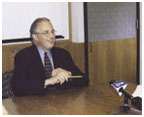 In
a voice unsteady with emotion, Harold T. Shapiro *64 announced his
resignation as Princeton's 18th president at a press conference
in Nassau Hall on September 22. Shapiro plans to finish out the
academic year - his 13th as president of the university - and then
take a year-long sabbatical before returning to teaching and research
as a professor at Princeton.
In
a voice unsteady with emotion, Harold T. Shapiro *64 announced his
resignation as Princeton's 18th president at a press conference
in Nassau Hall on September 22. Shapiro plans to finish out the
academic year - his 13th as president of the university - and then
take a year-long sabbatical before returning to teaching and research
as a professor at Princeton.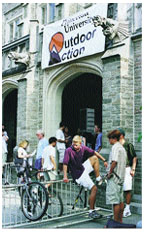 Of
the 1,160 freshmen, 59 percent arrived Labor Day weekend to participate
in Outdoor Action and Urban Action, annual week-long events designed
to begin the process of bringing a class together. Close to 600
students participated in various Outdoor Action trips, which included
areas in Pennsylvania, New Jersey, the Catskills, and the Appalachian
Trail. Another hundred participated in Urban Action at one of seven
locations in Princeton, Trenton, and Philadelphia. The rest of the
freshmen arrived September 9 for five days of orientation. (To see
the orientation schedule, go to http://www.princeton.edu/pr/ pub/oc/index.html.)
Of
the 1,160 freshmen, 59 percent arrived Labor Day weekend to participate
in Outdoor Action and Urban Action, annual week-long events designed
to begin the process of bringing a class together. Close to 600
students participated in various Outdoor Action trips, which included
areas in Pennsylvania, New Jersey, the Catskills, and the Appalachian
Trail. Another hundred participated in Urban Action at one of seven
locations in Princeton, Trenton, and Philadelphia. The rest of the
freshmen arrived September 9 for five days of orientation. (To see
the orientation schedule, go to http://www.princeton.edu/pr/ pub/oc/index.html.)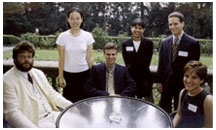 Student
award winners from left: Manfred Dietrich Laubichler GS, Peggy Ping
Hsu '03, Jared George Kramer '01, Jayanthi V. J. Wolf GS, Vance
Foster Serchuck '01, and Abbie Boggiano Liel '02.
Student
award winners from left: Manfred Dietrich Laubichler GS, Peggy Ping
Hsu '03, Jared George Kramer '01, Jayanthi V. J. Wolf GS, Vance
Foster Serchuck '01, and Abbie Boggiano Liel '02.  It
is a fact at campuses across the country that controversies regularly
bubble up - not unlike a famous geological wonder at Yellowstone
Park. Alumni write to the president, faculty members have strong
opinions, and administrators either accommodate alumni or hold to
the plan, usually approved by the Board of Trustees.
It
is a fact at campuses across the country that controversies regularly
bubble up - not unlike a famous geological wonder at Yellowstone
Park. Alumni write to the president, faculty members have strong
opinions, and administrators either accommodate alumni or hold to
the plan, usually approved by the Board of Trustees. Sitting
at the end of a cell's chromosomes are structures called telomeres,
which protect the chromosomes when the cell divides. Each time the
cell divides, the telomere shortens. When the telomere is gone,
the genetic material is exposed, and the cell ceases to divide,
eventually dying.
Sitting
at the end of a cell's chromosomes are structures called telomeres,
which protect the chromosomes when the cell divides. Each time the
cell divides, the telomere shortens. When the telomere is gone,
the genetic material is exposed, and the cell ceases to divide,
eventually dying.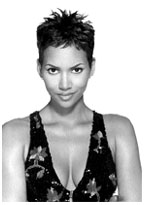 Mirjam
Foot lectured August 24 on "Bookbindings: Purpose, Use,
and Content: A Historical View." Foot recently retired as director
of collections and preservation in the British Library and is the
author of many books and articles about bookbinding.
Mirjam
Foot lectured August 24 on "Bookbindings: Purpose, Use,
and Content: A Historical View." Foot recently retired as director
of collections and preservation in the British Library and is the
author of many books and articles about bookbinding. Lin
A. Ferrand *88 (right), former associate professor of civil engineering
at the City University of New York, became associate dean of the
faculty last month. Ferrand earned her Ph.D. in the water resources
program at Princeton.
Lin
A. Ferrand *88 (right), former associate professor of civil engineering
at the City University of New York, became associate dean of the
faculty last month. Ferrand earned her Ph.D. in the water resources
program at Princeton. 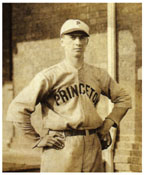 Moe
Berg '23, baseball catcher and spy and probably the most famous
member of his class, was the subject of an ESPN television biography
this summer. Berg signed with the Dodgers after graduating from
Princeton, where he majored in modern languages. He played baseball
for 15 years. During his off-seasons, he studied languages and earned
a law degree.
Moe
Berg '23, baseball catcher and spy and probably the most famous
member of his class, was the subject of an ESPN television biography
this summer. Berg signed with the Dodgers after graduating from
Princeton, where he majored in modern languages. He played baseball
for 15 years. During his off-seasons, he studied languages and earned
a law degree.